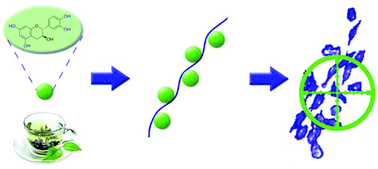Efficient functionalisation of dextran-aldehyde with catechin: potential applications in the treatment of cancer†
Abstract
Here, we report a simple and efficient method to functionalise dextran with catechin – a polyphenol present in red wine, red berries, and green tea. Aldehyde functionalised dextran was reacted with catechin in the presence of acetic acid to yield dextran-aldehyde-catechin conjugates via a condensation reaction. 1D and 2D (DOSY) 1H NMR and UV-Vis analyses were employed to characterise the polymers. The degree of catechin conjugation was easily manipulated by varying the aldehyde amount in the dextran, the catechin concentration and the reaction temperature and conjugates with up to 38 wt% catechin functionalisation were prepared. In particular, the conjugation reaction was found to be especially sensitive to temperature and this was shown to be partially due to the equilibrium between the aldehyde and the hemiacetal in dextran aldehyde shifting to a greater proportion of aldehyde groups as the temperature increased. The stability of the dextran–aldehyde–catechin conjugates was enhanced in comparison with native catechin in both deionised water and phosphate buffer solution. Finally, the anticancer properties of the dextran–aldehyde–catechin conjugates were investigated in vitro, demonstrating cytotoxic efficacy against neuroblastoma cells whilst showing no cytotoxicity towards normal cells.

- This article is part of the themed collection: Polymer Chemistry Lectureship Winners

 Please wait while we load your content...
Please wait while we load your content...